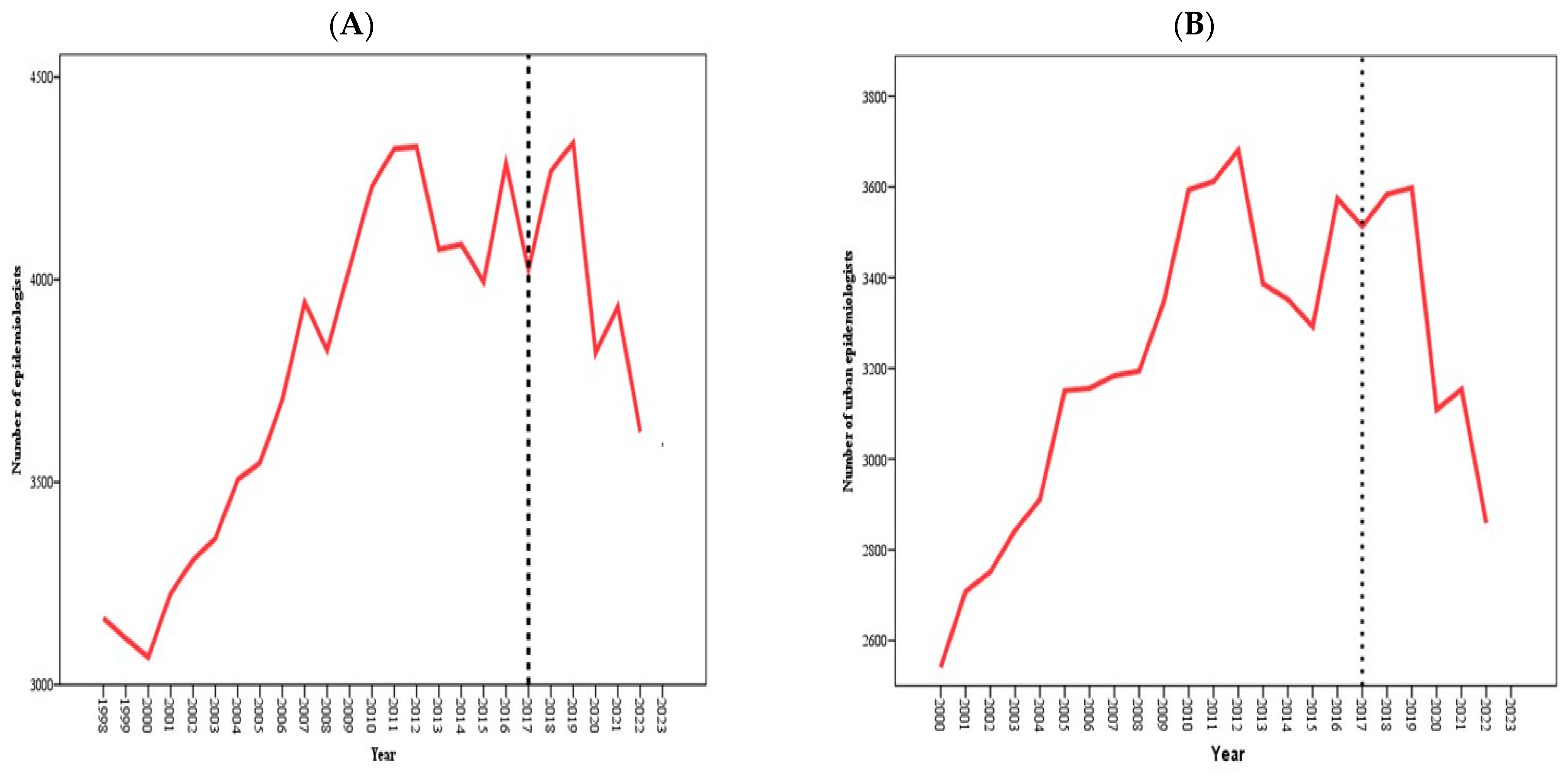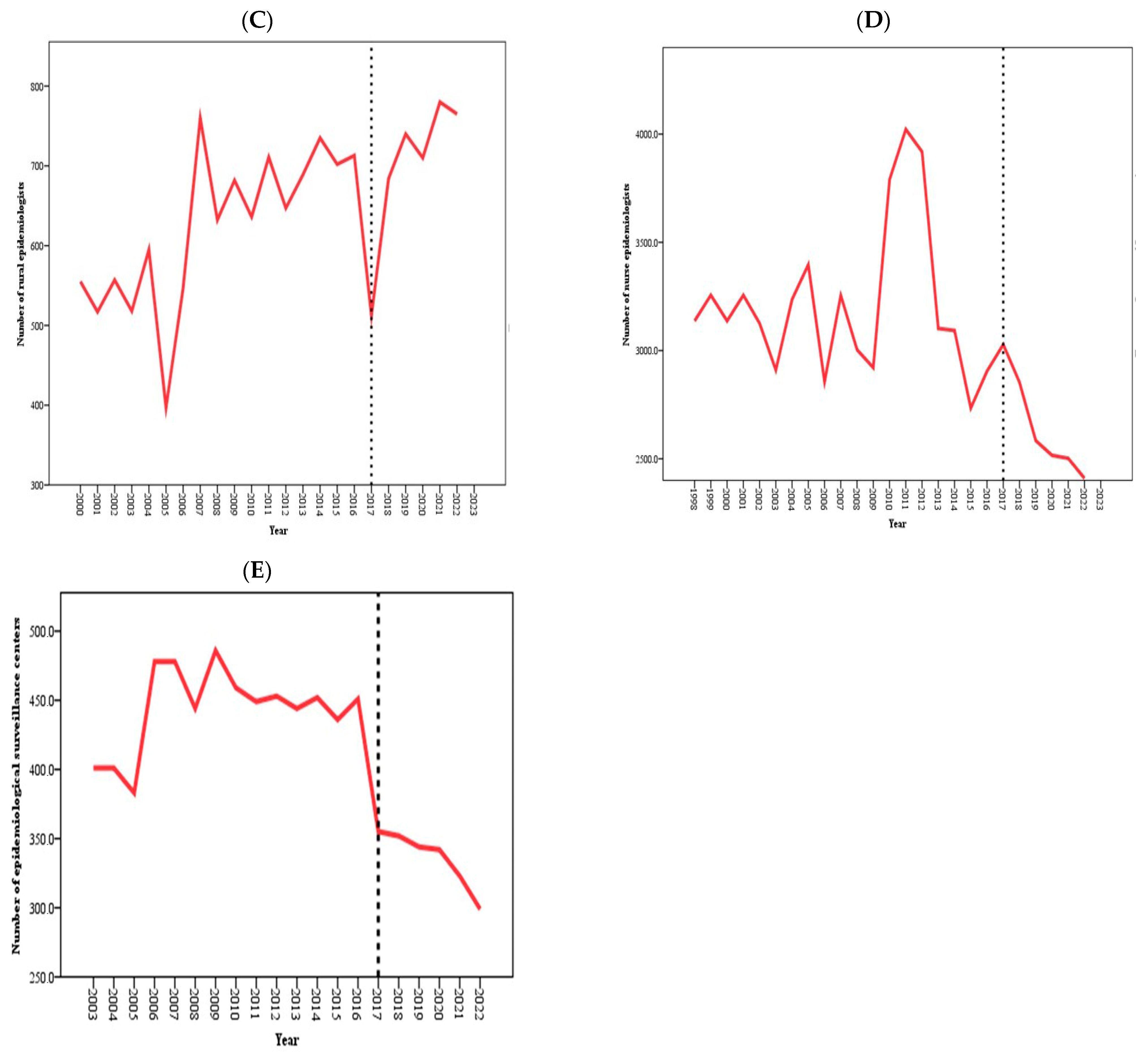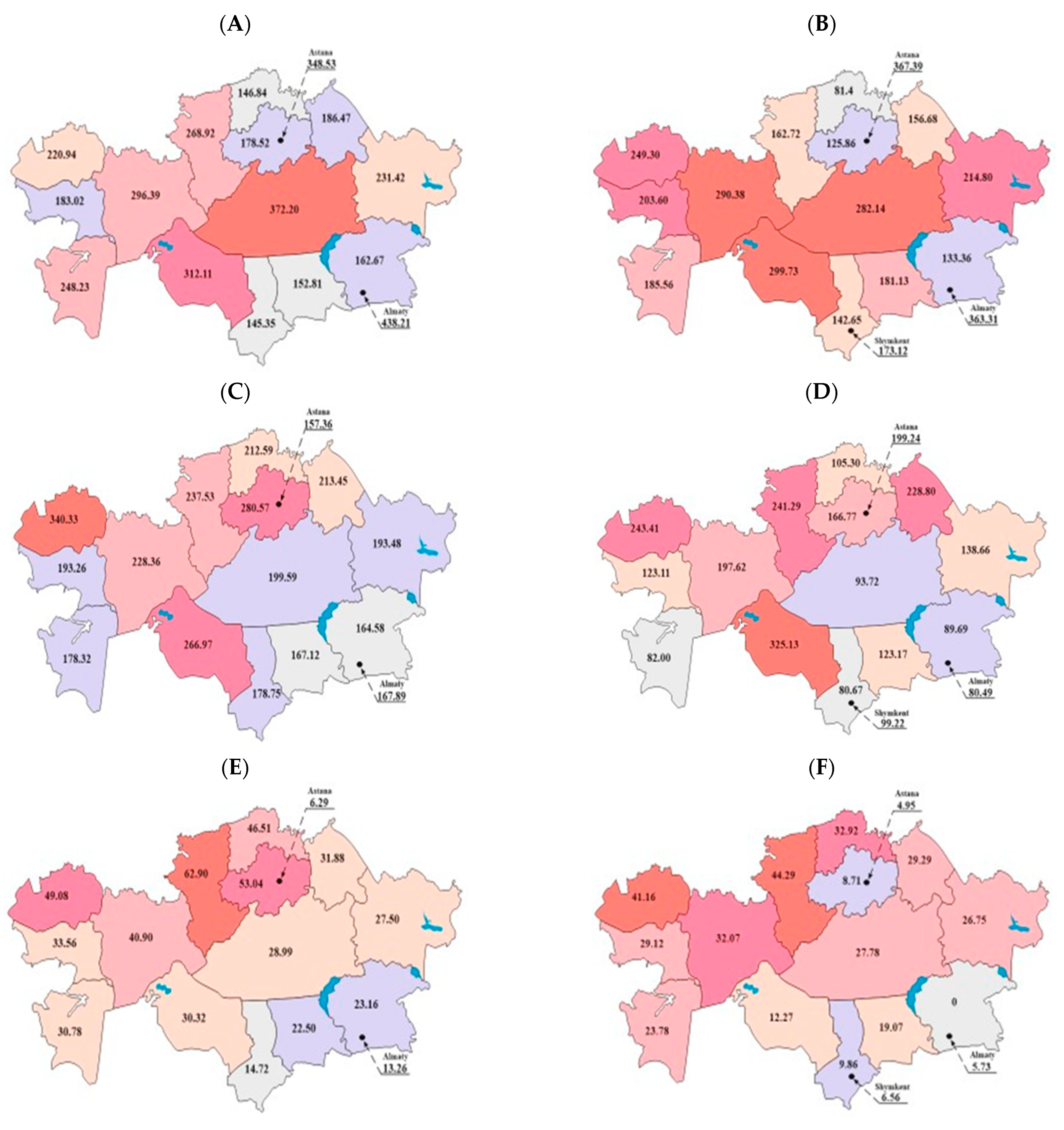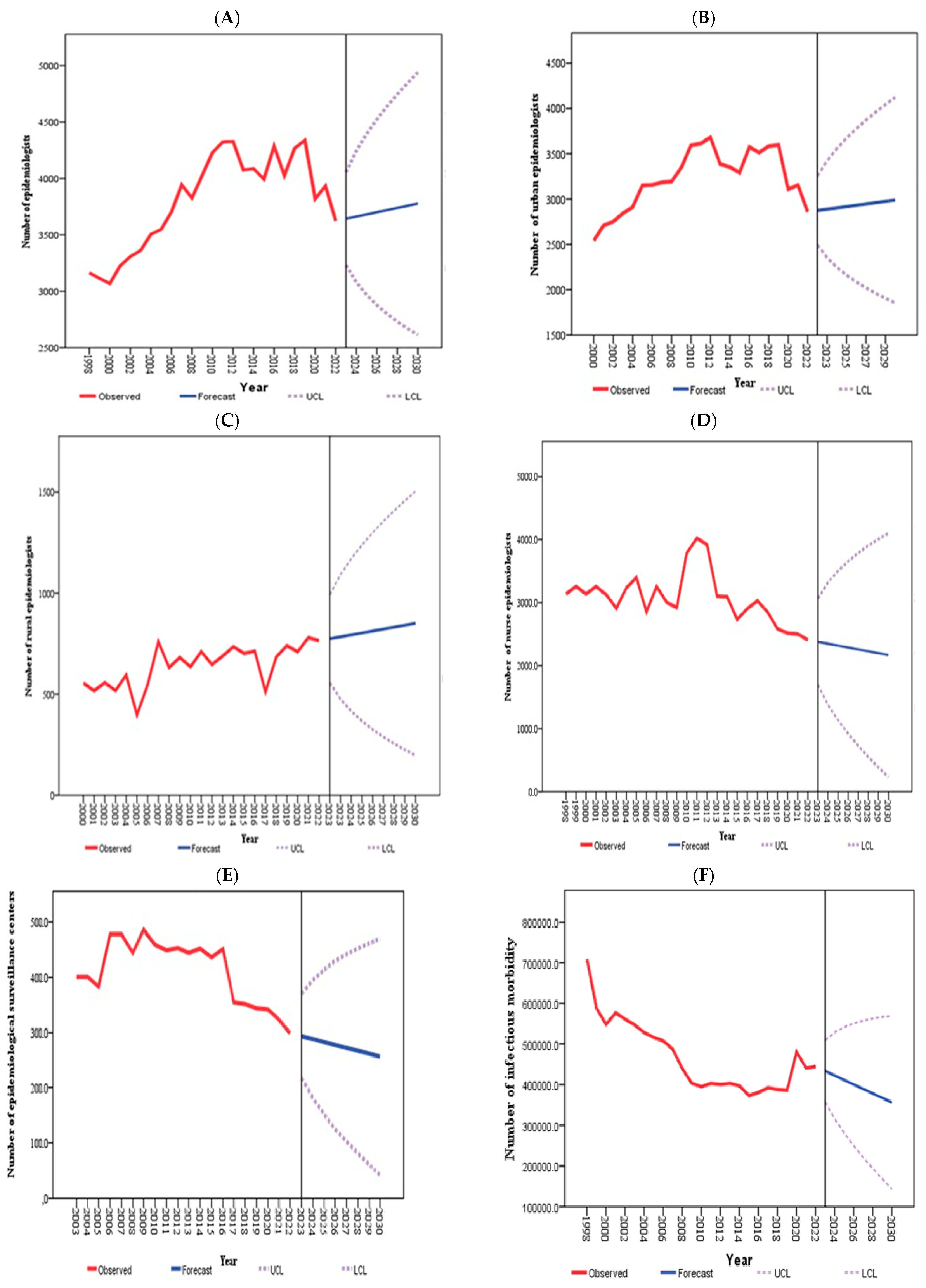The Impact of Healthcare Reforms on the Epidemiology Workforce in Kazakhstan: An Interrupted Time Series Analysis with Predictive Modeling of Nationwide Data Sources from 1998 to 2022
Abstract
1. Introduction
2. Materials and Methods
2.1. Study Design and Data Sources
2.2. Study Units
2.3. Study Formulas
2.4. Definitions Used in This Study
2.5. Data Analysis
2.6. Ethics Statement
3. Results
4. Discussion
5. Conclusions
Supplementary Materials
Author Contributions
Funding
Institutional Review Board Statement
Informed Consent Statement
Data Availability Statement
Acknowledgments
Conflicts of Interest
List of Abbreviations
| ARIMA | autoregressive integrated moving average |
| CI | Confidence interval |
| ITSA | Interrupted Time Series Analysis |
| MoH | Ministry of Health |
| PMP | per million population |
| PPC | percentage point change |
| SPSS | Statistical Package for Social Sciences |
| UNEHS | Unified National Electronic Healthcare System |
| WHO | World Health Organization |
References
- Arrazola, J.; Auer, S. Assessment of Epidemiology Capacity in State Health Departments—United States, 2021. MMWR Morb. Mortal. Wkly. Rep. 2022, 71, 484–488. [Google Scholar] [CrossRef] [PubMed]
- Williams, S.G.; Fontaine, R.E.; Turcios Ruiz, R.M.; Walke, H.; Ijaz, K.; Baggett, H.C. One Field Epidemiologist per 200,000 Population: Lessons Learned from Implementing a Global Public Health Workforce Target. Health Secur. 2020, 18, S113–S118. [Google Scholar] [CrossRef] [PubMed]
- Gotsadze, G.; Chikovani, I.; Goguadze, K.; Balabanova, D.; McKee, M. Reforming sanitary-epidemiological service in Central and Eastern Europe and the former Soviet Union: An exploratory study. BMC Public Health 2010, 10, 440. [Google Scholar] [CrossRef] [PubMed]
- Semenova, Y.; Lim, L.; Salpynov, Z.; Gaipov, A.; Jakovljevic, M. Historical evolution of healthcare systems of postsoviet Russia, Belarus, Kazakhstan, Kyrgyzstan, Tajikistan, Turkmenistan, Uzbekistan, Armenia, and Azerbaijan: A scoping review. Heliyon 2024, 10, e29550. [Google Scholar] [CrossRef]
- Maier, C.B.; Martin-Moreno, J.M. Quo vadis SANEPID? A cross-country analysis of public health reforms in 10 post-Soviet states. Health Policy 2011, 102, 18–25. [Google Scholar] [CrossRef] [PubMed]
- Richardson, E. Armenia: Health system review. Health Syst. Transit. 2013, 15, 1–99. [Google Scholar]
- Ibrahimov, F.; Ibrahimova, A.; Kehler, J.; Richardson, E. Azerbaijan: Health system review. Health Syst. Transit. 2010, 12, 1–117. [Google Scholar] [PubMed]
- Katsaga, A.; Kulzhanov, M.; Karanikolos, M.; Rechel, B. Kazakhstan: Health system review. Health Syst. Transit. 2012, 14, 1–154. [Google Scholar] [PubMed]
- Ibraimova, A.; Akkazieva, B.; Ibraimov, A.; Manzhieva, E.; Rechel, B. Kyrgyzstan: Health system review. Health Syst. Transit. 2011, 13, 1–152. [Google Scholar]
- Khodjamurodov, G.; Rechel, B. Tajikistan: Health system review. Health Syst. Transit. 2010, 12, 1–154. [Google Scholar]
- Requirements for SES for Business in the Republic of Kazakhstan Will Be Reduced by 85%. Available online: https://kz.kursiv.media/2017-07-21/trebovaniya-po-ses-dlya-biznesa-v-rk-budut-sokrascheny-na-85/ (accessed on 21 July 2017).
- Adilet. Order of the Minister of Health of the Republic of Kazakhstan Dated October 29, 2015 No. 375. Available online: https://adilet.zan.kz/rus/docs/K1500000375/links (accessed on 3 November 2015).
- Baiserkin, B.S.; Aikimbaev, A.M.; Bekshin, Z.M.; Kazakov, S.V.; Zhakashov, N.Z.; Sakiev, K.Z. History and Development Strategy of the Sanitary-Epidemiological Service of the Republic of Kazakhstan. Astana, 2013. 300p. Available online: https://webirbis.qmu.kz/lib/document/BOOK/4A59492B-EEA0-4E5C-A1B0-5270B68667EB/ (accessed on 2 February 2023).
- Salidat Kairbekova National Research Center for Health Development. Statistical Yearbooks “Public Health in the Republic of Kazakhstan and Activities of Healthcare Facilities”. Available online: https://www.nrchd.kz/index.php/ru/?option=com_content&view=article&id=973 (accessed on 21 April 2024).
- Gusmanov, A.; Zhakhina, G.; Yerdessov, S.; Sakko, Y.; Mussina, K.; Alimbayev, A.; Syssoyev, D.; Sarria-Santamera, A.; Gaipov, A. Review of the research databases on population-based Registries of Unified electronic Healthcare system of Kazakhstan (UNEHS): Possibilities and limitations for epidemiological research and Real-World Evidence. Int. J. Med. Inform. 2023, 170, 104950. [Google Scholar] [CrossRef] [PubMed]
- Jobalayeva, B.; Khismetova, Z.; Glushkova, N.; Kozhekenova, Z.; Abzaliyeva, A.; Berikuly, D.; Semenova, Y. The impact of incentive scheme on rural healthcare workforce availability: A case study of Kazakhstan. Hum. Resour. Health 2024, 22, 23. [Google Scholar] [CrossRef] [PubMed]
- Agency for Strategic Planning and Reforms of the Republic of Kazakhstan. Bureau of National Statistics. Statistical Collections. Available online: https://stat.gov.kz/ru/region/astana/spreadsheets/?industry=1461&year=&name=14519&period=&type= (accessed on 2 February 2023).
- Becerra, A.Z.; Ekundayo, O.; Salahuddin, M.; Onasanya, T.; Li, S.; “Navigating Careers as a Person of Color” Society of Epidemiology Research Pilot Mentoring Group. Diversity and inclusion in the epidemiology workforce. Am. J. Epidemiol. 2020, 189, 1023–1025. [Google Scholar] [CrossRef] [PubMed]
- Number of Sanitary and Anti-Epidemic Group and Public Hygiene doctors in Russia from 1990 to 2022. Available online: https://www.statista.com/statistics/1110848/number-of-epidemiologists-in-russia/ (accessed on 1 November 2023).
- Sanitary-Epidemiological Peace and Public Health Service (SANEPID) (Uzbekistan). Available online: https://www.devex.com/organizations/sanitary-epidemiological-peace-and-public-health-service-sanepid-uzbekistan-179746 (accessed on 27 January 2023).
- Decree of the President of the Republic of Uzbekistan, from 27.07.2020 № PP-4790. On Measures to Organize the Activities of the Service of Sanitary-Epidemiological Well-Being and Public Health of the Republic of Uzbekistan. Available online: https://lex.uz/docs/4914450 (accessed on 28 July 2020).
- History of Development of Sanitary-Epidemiological Service in the Kyrgyz Republic. Available online: https://dgsen.kg/glavnaYa-ru/istoriya.html (accessed on 10 July 2018).
- National Statistical Committee of the Kyrgyz Republic, Number of Medical Personnel. Available online: https://stat.gov.kg/en/opendata/category/4506/ (accessed on 9 March 2023).
- Kairzhan, B.; Izdenov, A.; Yerdessov, N. Occupational and Environmental Medicine. In Proceedings of the Conference: 28th International Symposium on Epidemiology in Occupational Health (EPICOH 2021), Montreal, QC, Canada, 25–28 October 2021; Volume 78, p. A102. [Google Scholar] [CrossRef]
- Adilet. Decree of the Government of the Republic of Kazakhstan Dated May 25, 2023 No. 32583. Available online: https://adilet.zan.kz/rus/docs/V2300032583 (accessed on 30 May 2023).
- Adilet. Decree of the Government of the Republic of Kazakhstan Dated April 26, 2024 No. 193. Available online: https://adilet.zan.kz/rus/docs/G24HN000193 (accessed on 6 May 2024).
- Global Antimicrobial Resistance and Use Surveillance System (GLASS) Report: 2022. Available online: https://www.who.int/publications/i/item/9789240062702 (accessed on 9 December 2022).
- O’Neill, J. Review on Antimicrobial Resistance: Tackling Drug-Resistant Infections Globally. 2016. Available online: https://amr-review.org/sites/default/files/160525_Final%20paper_with%20cover.pdf (accessed on 21 March 2023).
- Mounesan, L.; Mostafavi, E. The role of Epidemiologists in Tackling the Antimicrobial Resistance. 2019. Available online: https://www.researchgate.net/publication/337984413_The_role_of_epidemiologists_in_tackling_the_antimicrobial_resistance (accessed on 8 November 2019).




| Mean Before Intervention | Mean After Intervention | Mean Change | ||
|---|---|---|---|---|
| the adoption of the Entrepreneurial Code of the Republic of Kazakhstan and subsidiary legislation in 2017 | ||||
| Number | Total epidemiologists | 3747.16 | 4001.33 | 258.17 |
| Urban epidemiologists | 3192.76 | 3302.83 | 110.07 | |
| Rural epidemiologists | 623.12 | 698.5 | 75.38 | |
| Total nurse Epidemiologists | 3213.42 | 2648.83 | −564.59 | |
| Total epidemiological surveillance centers | 443.93 | 335.83 | −108.83 | |
| Per million population rates | Total epidemiologists | 235.22 | 214.39 | −20.83 |
| Urban epidemiologists | 351.93 | 307.44 | −44.48 | |
| Rural epidemiologists | 89.79 | 88.02 | −1.76 | |
| Nurse epidemiologists | 203.09 | 142.03 | −61.06 | |
| Total epidemiological surveillance centers | 27.42 | 17.99 | −9.43 | |
| Model Component | Model | Stationary R Squared | Estimate (PPC *) | p Value |
|---|---|---|---|---|
| Total number of epidemiologists | Brown (0.1.0) | 0.602 | 0.446 | <0.001 |
| Number of urban epidemiologists | Simple | −0.007 | 0.994 | <0.001 |
| Number of rural epidemiologists | ARIMA (0.1.0) | 0.167 | −201.0 | 0.048 |
| Total number of nurse epidemiologists | ARIMA (0.1.0) | 0.002 | 0.869 | <0.001 |
| Number of epidemiological surveillance centers | ARIMA (0.1.0) | 0.370 | −96.0 | 0.004 |
| Rate of total epidemiologists | ARIMA (0.1.0) | ˂0.001 | −0.005 | 0.625 |
| Rate of urban epidemiologists | Brown | 0.446 | 0.573 | <0.001 |
| Rate of rural epidemiologists | Simple | −2.309 | 89.327 | <0.001 |
| Rate of nurse epidemiologists | Simple | −0.02 | 0.871 | <0.001 |
| Rate of epidemiological surveillance centers | ARIMA (0.1.0) | 0.285 | −5.665 | 0.007 |
| Indicator | Mean Before Intervention | Mean After Intervention | Mean Change | Mean Change Related to Preintervention Period, % |
|---|---|---|---|---|
| the adoption of the Entrepreneurial Code of the Republic of Kazakhstan and subsidiary legislation in 2017 | ||||
| Number of infectious morbidity | 482,159.2 | 421,873 | −60,286.2 | −12.50 |
| Infectious morbidity rate | 3077.84 | 2254.22 | −823.619 | −26.76 |
| Number of infectious morbidities per epidemiologist | 128.82 | 105.43 | −23.38 | −18.15 |
| Number | Year | Model Parameters | |||
|---|---|---|---|---|---|
| 2026 Rate (95% CI *) | 2030 Rate (95% CI) | Type of Model | Alpha (Level) | ||
| T | p Value | ||||
| Total epidemiologists | 3701 (2878; 4523) | 3777 (2614; 4941) | ARIMA (0.1.0) | 0.472 | 0.641 |
| Urban epidemiologists | 2917 (2160; 3673) | 2975 (1905; 4044) | ARIMA (0.1.0) | 0.373 | 0.713 |
| Rural epidemiologists | 803 (367; 1239) | 841 (225; 1458) | ARIMA (0.1.0) | 0.427 | 0.673 |
| Total nurse epidemiologists | 2289 (921; 3657) | 2168 (233; 4102) | ARIMA (0.1.0) | −0.449 | 0.658 |
| Epidemiological surveillance centers | 277.5 (126; 429.1) | 256.1 (256.1; 470.4) | ARIMA (0.1.0) | −0.649 | 0.525 |
| Infectious morbidity | 400,218.8 (249,525.6; 550,912.1) | 356,237.7 (569,350.1; 143,125.3) | ARIMA (0.1.0) | −1.479 | 0.153 |
| Rate of total epidemiologists | 181.8 (145.32; 224.91) | 178.954 (129.948; 241.001) | ARIMA (0.1.0) | −0.495 | 0.625 |
| Rate of urban epidemiologists | 241.607 (162.393; 320.821) | 231.957 (119.932; 343.982) | ARIMA (0.1.0) | −0.594 | 0.559 |
| Rate of rural epidemiologists | 89.327 (66.505; 112.149) | 89.327 (66.505; 112.149) | ARIMA (0.0.0) | 38.929 | <0.001 |
| Rate of nurse epidemiologists | 114.905 (73.402; 172.378) | 107.499 (56.329; 188.405) | ARIMA (0.1.0) | −1.044 | 0.308 |
| Rate of epidemiological surveillance centers | 12.783 (3.516; 22.051) | 10.329 (−2.777; 23.435) | ARIMA (0.1.0) | −1.213 | 0.241 |
| Rate of infectious morbidity | 1858.1 (961.54; 2754.58) | 1452.3 (184.47; 2720.21) | ARIMA (0.1.0) | −2.29 | 0.031 |
Disclaimer/Publisher’s Note: The statements, opinions and data contained in all publications are solely those of the individual author(s) and contributor(s) and not of MDPI and/or the editor(s). MDPI and/or the editor(s) disclaim responsibility for any injury to people or property resulting from any ideas, methods, instructions or products referred to in the content. |
© 2025 by the authors. Licensee MDPI, Basel, Switzerland. This article is an open access article distributed under the terms and conditions of the Creative Commons Attribution (CC BY) license (https://creativecommons.org/licenses/by/4.0/).
Share and Cite
Akpanova, T.; Rakhypbekov, T.; Semenova, Y.; Mussakhanova, A.; Turgambayeva, A.; Zhanaliyeva, M.; Zharilkassimov, R.; Kim, S.; Alzhanova, A.; Sekenova, R.; et al. The Impact of Healthcare Reforms on the Epidemiology Workforce in Kazakhstan: An Interrupted Time Series Analysis with Predictive Modeling of Nationwide Data Sources from 1998 to 2022. Healthcare 2025, 13, 170. https://doi.org/10.3390/healthcare13020170
Akpanova T, Rakhypbekov T, Semenova Y, Mussakhanova A, Turgambayeva A, Zhanaliyeva M, Zharilkassimov R, Kim S, Alzhanova A, Sekenova R, et al. The Impact of Healthcare Reforms on the Epidemiology Workforce in Kazakhstan: An Interrupted Time Series Analysis with Predictive Modeling of Nationwide Data Sources from 1998 to 2022. Healthcare. 2025; 13(2):170. https://doi.org/10.3390/healthcare13020170
Chicago/Turabian StyleAkpanova, Togzhan, Tolebay Rakhypbekov, Yuliya Semenova, Akmaral Mussakhanova, Assiya Turgambayeva, Marina Zhanaliyeva, Ruslan Zharilkassimov, Sergey Kim, Aigerim Alzhanova, Raushan Sekenova, and et al. 2025. "The Impact of Healthcare Reforms on the Epidemiology Workforce in Kazakhstan: An Interrupted Time Series Analysis with Predictive Modeling of Nationwide Data Sources from 1998 to 2022" Healthcare 13, no. 2: 170. https://doi.org/10.3390/healthcare13020170
APA StyleAkpanova, T., Rakhypbekov, T., Semenova, Y., Mussakhanova, A., Turgambayeva, A., Zhanaliyeva, M., Zharilkassimov, R., Kim, S., Alzhanova, A., Sekenova, R., & Dauletyarova, M. (2025). The Impact of Healthcare Reforms on the Epidemiology Workforce in Kazakhstan: An Interrupted Time Series Analysis with Predictive Modeling of Nationwide Data Sources from 1998 to 2022. Healthcare, 13(2), 170. https://doi.org/10.3390/healthcare13020170






